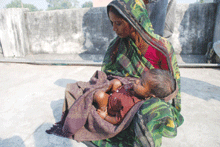To the long list of dubious distinctions of the Hindi heartland state of Uttar Pradesh (pop. 166 million), add one more. UP is the most dangerous state in the country to bear children.
 According to the recently released State of the World’s Children 2009 report of the United Nations Children’s Fund (Unicef), the maternal mortality rate in UP is 1:42 whereas in the southern state Kerala it’s 1:500. Translated, this statistic implies that UP ‘contributes’ one-third of all the maternal child-birth deaths in India. In turn this means that an infant born in India’s most populous state has minimal chances of survival, given that babies whose mothers die during the first six weeks of delivery are more likely to die within two years.
According to the recently released State of the World’s Children 2009 report of the United Nations Children’s Fund (Unicef), the maternal mortality rate in UP is 1:42 whereas in the southern state Kerala it’s 1:500. Translated, this statistic implies that UP ‘contributes’ one-third of all the maternal child-birth deaths in India. In turn this means that an infant born in India’s most populous state has minimal chances of survival, given that babies whose mothers die during the first six weeks of delivery are more likely to die within two years.
Releasing the report on January 16, Unicef’s UP chief Adele Khudr said as much: “UP is the riskiest state for a woman to have a baby in the country. Interventions that save the life of new mothers are beneficial for their babies because survival of mothers is linked to survival of their infants.”
According to the report, UP ranks third in the list of neo-natal mortality rates (death within the first 28 days of birth) with 46 children dying per 1,000 live births, after Orissa (52) and Madhya Pradesh (51). The authors of SWC 2009 have taken pains to reiterate that 80 percent of causes of neo-natal deaths — diarrhoea, tetanus and asphyxia — can be prevented by vaccination or good hygiene. Moreover the report highlights that 75 percent of pregnant women in UP deliver their babies at home, without any medical or para medical assistance.
Savitri Joshi, a healthcare activist working in Lucknow’s rural fringes, says there is a vicious cycle of perception and ignorance in India’s most populous state. “The poor perceive the state’s health service and its providers as inadequate and inaccessible. Thus, even where the government has been able to set up healthcare infrastructure, it’s fallen into disuse, while with the lack of facilities young doctors are simply not interested in serving in rural areas.”
R.S. Dubey, medical superintendent of Lucknow’s RML Hospital, blames UP’s abysmal mother and child healthcare record to deliberate government disinterest in the poor. “The government is not really interested in improving the healthcare system. A number of grandiose schemes, including public-private partnership initiatives, have been floated, but the results have been discouraging,” he says.
Nor is SWC 2009 the sole report to paint a grim picture of UP’s child and maternal healthcare system. According to the third National Family Health Survey, 74.7 percent of pregnant women never make ante-natal care visits to healthcare centres. Also, only 8.7 percent of mothers consume iron folic acid tablets for 90 days or more. And more than 60 percent of pregnant women in the state are severely anaemic at any given point of time. Against this backdrop, it’s unsurprising that in this Hindi heartland state, 52 percent of children are severely malnourished, against the low but still shameful 43 percent all-India average.
However, Unicef’s Khudr (quoted earlier) chose to inject a dose of hope into the grim message of the report by discerning “some progress” in the provision of healthcare for the masses. But it is noteworthy that no political party in the state has expressed ire and outrage about the damning indictment of SWC 2009. The conclusion is inesc-apable: women and children count for nothing in India’s most populous state.
Vidya Pandit (Lucknow)